Our basic rights seem to be in the center of today’s political discussions. Such rights as Freedom of Speech and Freedom of Privacy seem to be constantly under attack in the current climate in this country. But imagine a time where there were no rights for religious worship. There was only one church and one man mandated that it was that particular church that was to be worshipped or else. This happened a little more than 350 years ago. But instead of allowing it to happen, a group of individuals decided to stop taking the abuse and stand up for themselves. The outcome of their actions led to the basic foundations that we now find within The Bill of Rights. These individuals were part of the Society of Friends, or as we know them today: The Quakers.
The Society of Friends was established in England by George Fox in the year 1652. The Quakers (as they were negatively called but grew to accept the moniker) followed a simple life that involved honesty, compassion and equality for all. It was through their actions that they chose to enlighten the newly “discovered” world to their beliefs. It was in the City of Boston that the Quakers met their toughest resistance.
In the Pilgrim stronghold of Boston, the Quakers were regularly ridiculed and persecuted for their beliefs. It is ironic to note, that the Pilgrims, who were also persecuted for their religious beliefs in Europe, found the freedom to practice their religion as they saw fit in Holland, but were unable to extend the same courtesy to the Quakers in Massachusetts. It was in 1657, that the Quakers saw an opportunity to practice their faith in peace. Henry Townsend who lived in Vlissingen (Current Day Flushing, New York) offered safe passage for those Quakers who wanted to leave any place that they had been persecuted. The plan worked well until it caught the eye of the Dutch Director-General of New Amsterdam, Peter Stuyvesant, who himself was a religious man but of the Dutch Reformed Church.
Peter Stuyvesant was brought in by The Dutch West Indies company to provide stable leadership to their fledgling business colony. Before Stuyvesant’s arrival, the colony was plagued by infighting between colonists, massive drinking and unruliness among the natives and the colonists. With Stuyvesant’s arrival in 1647 he attempted to being about order by closing brothels, enforcing religious observation on Sundays and of curbing the sale of arms and tobacco to the natives. It was with the enforcement of the religious observation that brought the Quakers into direct conflict with Stuyvesant.
Though the Dutch West Indies Company had no official rule about what religious practices were allowed, Stuyvesant took it upon himself to act on behalf of the Dutch Reformed Church. So when Townsend started to house his fellow Quakers, Stuyvesant fined him and had him shipped back to Holland. It was because of this that a group of Quakers got together and drafted a document that would be now known as The Flushing Remonstrance. Signed on December 27, 1657 it was within this document that they listed their displeasure with the persecution of their faith and how they believed it was their right to practice their faith, as they believed. They signed the document and had it delivered to Stuyvesant himself. This further caused Stuyvesant to go against the Quakers.
It wasn’t until the year 1662 that things came to a head. John Bowne went against the decrees and rules of Stuyvesant by continuing to house Quakers and allowing them to conduct their services under his roof. Stuyvesant had Bowne arrested in his own home and when he refused to renounce his faith, he was jailed and tortured for 3 months before being exiled to Holland.
Upon his arrival in Holland, Bowne pled his case to the directors of the Dutch West Indies Company. The directors acquitted Bowne of all charges and allowed him to return to New Amsterdam with specific rules for Stuyvesant to allow all people in the colony to practice their religious beliefs free from persecution. The rule stayed in place even when the British taking control of New Amsterdam a year later. Here is the official text of the Flushing Remonstrance:
December 27, 1657
Right Honorable,
You have been pleased to send up unto us a certain prohibition or command that we should not receive or entertain any of those people called Quakers because they are supposed to be by some, seducers of the people. For our part we cannot condemn them in this case, neither can we stretch out our hands against them, to punish, banish or persecute them for out of Christ God is a consuming fire, and it is a fearful thing to fall into the hands of the living God.
We desire therefore in this case not to judge least we be judged, neither to condemn least we be condemned, but rather let every man stand and fall to his own Master. Wee are bounde by the Law to Doe good unto all men, especially to those of the household of faith. And though for the present we seem to be unsensible of the law and the Law giver, yet when death and the Law assault us, if we have our advocate to seeke, who shall plead for us in this case of conscience betwixt God and our own souls; the powers of this world can neither attack us, neither excuse us, for if God justifye who can condemn and if God condemn there is none can justify.
And for those jealousies and suspicions which some have of them, that they are destructive unto Magistracy and Minssereye, that can not bee, for the magistrate hath the sword in his hand and the minister hath the sword in his hand, as witnesse those two great examples which all magistrates and ministers are to follow, Moses and Christ, whom God raised up maintained and defended against all the enemies both of flesh and spirit; and therefore that which is of God will stand, and that which is of man will come to nothing. And as the Lord hath taught Moses or the civil power to give an outward liberty in the state by the law written in his heart designed for the good of all, and can truly judge who is good, who is civil, who is true and who is false, and can pass definite sentence of life or death against that man which rises up against the fundamental law of the States General; soe he hath made his ministers a savor of life unto life, and a savor of death unto death.
The law of love, peace and liberty in the states extending to Jews, Turks, and Egyptians, as they are considered the sonnes of Adam, which is the glory of the outward state of Holland, soe love, peace and liberty, extending to all in Christ Jesus, condemns hatred, war and bondage. And because our Saviour saith it is impossible but that offenses will come, but woe unto him by whom they cometh, our desire is not to offend one of his little ones, in whatsoever form, name or title he appears in, whether Presbyterian, Independent, Baptist or Quaker, but shall be glad to see anything of God in any of them, desiring to doe unto all men as we desire all men should doe unto us, which is the true law both of Church and State; for our Savior saith this is the law and the prophets. Therefore, if any of these said persons come in love unto us, wee cannot in conscience lay violent hands upon them, but give them free egresse and regresse unto our Town, and houses, as God shall persuade our consciences. And in this we are true subjects both of Church and State, for we are bounde by the law of God and man to doe good unto all men and evil to noe man. And this is according to the patent and charter of our Towne, given unto us in the name of the States General, which we are not willing to infringe, and violate, but shall houlde to our patent and shall remaine, your humble subjects, the inhabitants of Vlishing.
Written this 27th day of December, in the year 1657 , by mee
Edward Heart, Clericus
Additional Signers
Tobias Feake
Nathaniell Tue
The marke of William Noble
Nicholas Blackford
William Thorne, Seignior
The marke of Micah Tue
The marke of William Thorne, Jr.
The marke of Philip Ud
Edward Tarne
Robert Field, senior
John Store
Robert Field, junior
Nathaniel Hefferd
Nich Colas Parsell
Benjamin Hubbard
Michael Milner
The marke of William Pidgion
Henry Townsend
The marke of George Clere
George Wright
Elias Doughtie
John Foard
Antonie Feild
Henry Semtell
Richard Stocton
Edward Hart
Edward Griffine
John Mastine
John Townesend
Edward Farrington
Ever been interested in the History of New York City? I have and still find myself intrigued on how much has happened and continues to occur in the Greatest City of the World. Join us as we discuss dates, places and faces along the historical landscape of NYC
Saturday, December 29, 2007
Tuesday, December 25, 2007
Houston Street? Who is it really named after!!
The funny thing about working in bars in NYC is how much you have to know about the area where you work in order to do your job. For example, when I worked at Fraunces Tavern, much of my day was spent informing patrons about who the place was named after (Samuel “Black Sam” Fraunces), where George Washington gave his farewell to his troops (The Long Room) and what other historical buildings were in the area (Federal Hall, Trinity Church, New York Stock Exchange among others). Now that I am once again working in the East Village, a whole slew of new questions have come about (In addition to some old ones). There is one question in particular that I would like to share the answer with you.
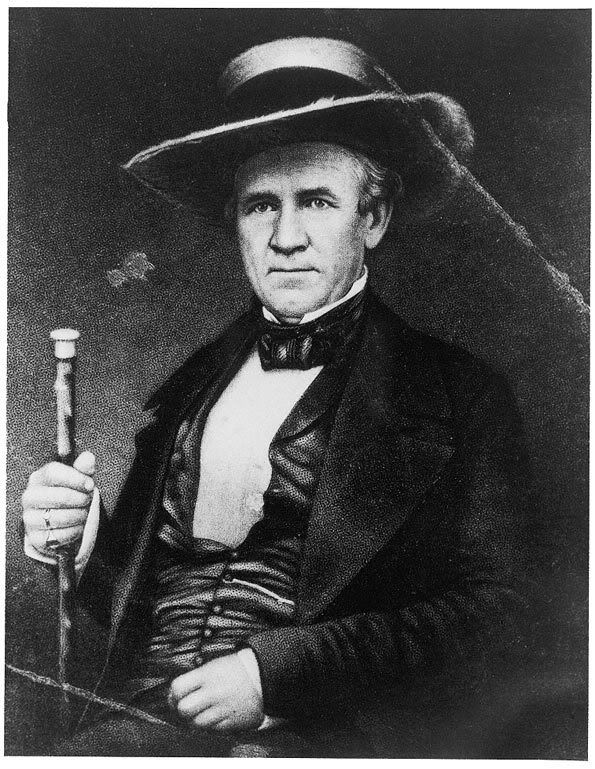 It never fails that I get people from Texas asking me where Houston (“HEW” ston) Street is. When I tell them that it is Houston (“HOW” ston) Street they often give me the look which says “Why is it pronounced Houston (“HOW” ston) if it says Houston (“HEW” ston). At first I thought that it was named after Texas native Sam Houston. Then I thought that maybe it was New York City’s way of being different to change the pronunciation of the name. After getting tired of making excuses, I decided to find out why Houston Street pronounced the way it is. So here goes.
It never fails that I get people from Texas asking me where Houston (“HEW” ston) Street is. When I tell them that it is Houston (“HOW” ston) Street they often give me the look which says “Why is it pronounced Houston (“HOW” ston) if it says Houston (“HEW” ston). At first I thought that it was named after Texas native Sam Houston. Then I thought that maybe it was New York City’s way of being different to change the pronunciation of the name. After getting tired of making excuses, I decided to find out why Houston Street pronounced the way it is. So here goes.
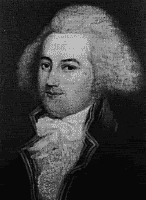 The street is not named after Sam Houston. It is named after William Houstoun (1755-1813), a native of Savannah Georgia. Who was William Houstoun you may ask, well here he is. William Houstoun was a lawyer from Georgia who was a member of the delegation from Georgia to both The Continental Congress from 1783 through 1786 and The Constitutional Convention in 1787. Pretty impressive but why is he linked with NYC.
The street is not named after Sam Houston. It is named after William Houstoun (1755-1813), a native of Savannah Georgia. Who was William Houstoun you may ask, well here he is. William Houstoun was a lawyer from Georgia who was a member of the delegation from Georgia to both The Continental Congress from 1783 through 1786 and The Constitutional Convention in 1787. Pretty impressive but why is he linked with NYC.
Houstoun married into the Bayard family by wedding Mary Bayard on June 10, 1786. They were married until her death on August 7, 1806. The Bayard family lands laid within the areas of today’s West and East Villages and Houstoun Street cut through the middle of the land. Now see how I spelled the street as Houstoun instead of Houston. In my research, the street was correctly spelled as Houstoun Street up to the early 1800’s. When the spelling was changed to Houston Street is not known but if I find it out I will update the post.
Upon his death in on March 17, 1813, his body was brought to NYC from Savannah and interred at St. Paul’s Chapel.
So there is the actual origin behind Houston Street, NYC.
 It never fails that I get people from Texas asking me where Houston (“HEW” ston) Street is. When I tell them that it is Houston (“HOW” ston) Street they often give me the look which says “Why is it pronounced Houston (“HOW” ston) if it says Houston (“HEW” ston). At first I thought that it was named after Texas native Sam Houston. Then I thought that maybe it was New York City’s way of being different to change the pronunciation of the name. After getting tired of making excuses, I decided to find out why Houston Street pronounced the way it is. So here goes.
It never fails that I get people from Texas asking me where Houston (“HEW” ston) Street is. When I tell them that it is Houston (“HOW” ston) Street they often give me the look which says “Why is it pronounced Houston (“HOW” ston) if it says Houston (“HEW” ston). At first I thought that it was named after Texas native Sam Houston. Then I thought that maybe it was New York City’s way of being different to change the pronunciation of the name. After getting tired of making excuses, I decided to find out why Houston Street pronounced the way it is. So here goes.  The street is not named after Sam Houston. It is named after William Houstoun (1755-1813), a native of Savannah Georgia. Who was William Houstoun you may ask, well here he is. William Houstoun was a lawyer from Georgia who was a member of the delegation from Georgia to both The Continental Congress from 1783 through 1786 and The Constitutional Convention in 1787. Pretty impressive but why is he linked with NYC.
The street is not named after Sam Houston. It is named after William Houstoun (1755-1813), a native of Savannah Georgia. Who was William Houstoun you may ask, well here he is. William Houstoun was a lawyer from Georgia who was a member of the delegation from Georgia to both The Continental Congress from 1783 through 1786 and The Constitutional Convention in 1787. Pretty impressive but why is he linked with NYC. Houstoun married into the Bayard family by wedding Mary Bayard on June 10, 1786. They were married until her death on August 7, 1806. The Bayard family lands laid within the areas of today’s West and East Villages and Houstoun Street cut through the middle of the land. Now see how I spelled the street as Houstoun instead of Houston. In my research, the street was correctly spelled as Houstoun Street up to the early 1800’s. When the spelling was changed to Houston Street is not known but if I find it out I will update the post.
Upon his death in on March 17, 1813, his body was brought to NYC from Savannah and interred at St. Paul’s Chapel.
So there is the actual origin behind Houston Street, NYC.
Thursday, July 5, 2007
Lou Gehrig July 4, 1939
When you think about July 4th, images that come to mind are barbecues, picnic, beach gatherings and baseball. It is within this last image that I present today’s blog. Baseball and the 4th of July (In my humble opinion) go hand in hand. In terms of the Yankees, many historical moments have occurred on July 4th. From Phil Neikro’s 3,000 strikeout (1984), to Dave Righetti’s no hitter against the Red Sox (1983), the fabled 15 inning, 1-0 pitching duel between the Yanks’ Herb Pennock and Philadelphia’s Lefty Grove (1925) many a memorable moment has occurred on the legendary field at Yankee Stadium. But one event that stands alone apart from the events, I’ve previously mentioned is one that did not involve a play on the field. On July 4th, 1939, a legendary player said goodbye to both his teammates and the faithful in the stands. Lou Gehrig (1903-1941) bade farewell, falling to the disease that would bear his name.
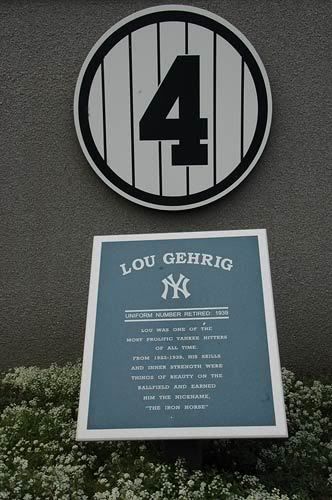 Lou Gehrig, a native of New York City played 1st base for the fabled New York Yankees. His storied career spanned 17 years, from 1923 to 1939 cementing himself as a true legend of the game. Playing along side fellow Hall of Famer Babe Ruth, the formidable duo wreaked havoc among opposing pitching. Not only was Gehrig known for his offensive prowess, he was also the model of consistency in the field playing for a total of 2,130 consecutive games until he was felled by a fatal disease.
Lou Gehrig, a native of New York City played 1st base for the fabled New York Yankees. His storied career spanned 17 years, from 1923 to 1939 cementing himself as a true legend of the game. Playing along side fellow Hall of Famer Babe Ruth, the formidable duo wreaked havoc among opposing pitching. Not only was Gehrig known for his offensive prowess, he was also the model of consistency in the field playing for a total of 2,130 consecutive games until he was felled by a fatal disease.
Amyotrophic lateral sclerosis (commonly known ALS) often referred to as "Lou Gehrig's disease" is a progressive neurodegenerative disease that affects nerve cells in the brain and the spinal cord. Motor neurons reach from the brain to the spinal cord and from the spinal cord to the muscles throughout the body. The progressive degeneration of the motor neurons in ALS eventually leads to their death. When the motor neurons die the ability of the brain to initiate and control muscle movement is lost. With voluntary muscle action progressively affected, patients in the later stages of the disease may become totally paralyzed.
At first, Gehrig skills slowly degenerated. Plays that Gehrig made with ease seemed to take more effort to make. Balls that Gehrig easily sent into the stands were now easy pop-outs. Even normal activities such as walking short distances were a chore for Gehrig. It was within this scenario, that on May 2, 1939, that as Yankee captain Lou Gehrig played his final game for the Yankees.
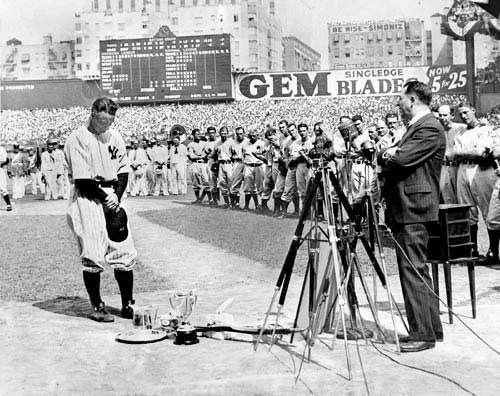
It was at the suggestion of New York sportswriter Paul Gallico for a day of recognition for Gehrig, that July 4th, 1939 will be forever linked to Yankee history. In front of over 62,000 fans and many teammates (including Babe Ruth), Lou Gehrig gave his famous and emotional farewell speech. Fighting back tears, Gehrig uttered the following words:
"Fans, for the past two weeks you have been reading about the bad break I got. Yet today I consider myself the luckiest man on the face of this earth. I have been in ballparks for seventeen years and have never received anything but kindness and encouragement from you fans.
"Look at these grand men. Which of you wouldn't consider it the highlight of his career just to associate with them for even one day? Sure, I'm lucky. Who wouldn't consider it an honor to have known Jacob Ruppert? Also, the builder of baseball's greatest empire, Ed Barrow? To have spent six years with that wonderful little fellow, Miller Huggins? Then to have spent the next nine years with that outstanding leader, that smart student of psychology, the best manager in baseball today, Joe McCarthy? Sure, I'm lucky.
"When the New York Giants, a team you would give your right arm to beat, and vice versa, sends you a gift - that's something. When everybody down to the groundskeepers and those boys in white coats remember you with trophies - that's something. When you have a wonderful mother-in-law who takes sides with you in squabbles with her own daughter - that's something. When you have a father and a mother who work all their lives so you can have an education and build your body - it's a blessing. When you have a wife who has been a tower of strength and shown more courage than you dreamed existed - that's the finest I know.
"So I close in saying that I may have had a tough break, but I have an awful lot to live for. Thank you."

For the audio version of the speech, click on any of the following links:
Lou Gehrig passed on almost two years later. On June 2, 1941, Lou succumbed to the disease that would bear his name. His ashes are buried at Kensico Cemetary in Valhalla New York.
 Lou Gehrig, a native of New York City played 1st base for the fabled New York Yankees. His storied career spanned 17 years, from 1923 to 1939 cementing himself as a true legend of the game. Playing along side fellow Hall of Famer Babe Ruth, the formidable duo wreaked havoc among opposing pitching. Not only was Gehrig known for his offensive prowess, he was also the model of consistency in the field playing for a total of 2,130 consecutive games until he was felled by a fatal disease.
Lou Gehrig, a native of New York City played 1st base for the fabled New York Yankees. His storied career spanned 17 years, from 1923 to 1939 cementing himself as a true legend of the game. Playing along side fellow Hall of Famer Babe Ruth, the formidable duo wreaked havoc among opposing pitching. Not only was Gehrig known for his offensive prowess, he was also the model of consistency in the field playing for a total of 2,130 consecutive games until he was felled by a fatal disease.Amyotrophic lateral sclerosis (commonly known ALS) often referred to as "Lou Gehrig's disease" is a progressive neurodegenerative disease that affects nerve cells in the brain and the spinal cord. Motor neurons reach from the brain to the spinal cord and from the spinal cord to the muscles throughout the body. The progressive degeneration of the motor neurons in ALS eventually leads to their death. When the motor neurons die the ability of the brain to initiate and control muscle movement is lost. With voluntary muscle action progressively affected, patients in the later stages of the disease may become totally paralyzed.
At first, Gehrig skills slowly degenerated. Plays that Gehrig made with ease seemed to take more effort to make. Balls that Gehrig easily sent into the stands were now easy pop-outs. Even normal activities such as walking short distances were a chore for Gehrig. It was within this scenario, that on May 2, 1939, that as Yankee captain Lou Gehrig played his final game for the Yankees.

It was at the suggestion of New York sportswriter Paul Gallico for a day of recognition for Gehrig, that July 4th, 1939 will be forever linked to Yankee history. In front of over 62,000 fans and many teammates (including Babe Ruth), Lou Gehrig gave his famous and emotional farewell speech. Fighting back tears, Gehrig uttered the following words:
"Fans, for the past two weeks you have been reading about the bad break I got. Yet today I consider myself the luckiest man on the face of this earth. I have been in ballparks for seventeen years and have never received anything but kindness and encouragement from you fans.
"Look at these grand men. Which of you wouldn't consider it the highlight of his career just to associate with them for even one day? Sure, I'm lucky. Who wouldn't consider it an honor to have known Jacob Ruppert? Also, the builder of baseball's greatest empire, Ed Barrow? To have spent six years with that wonderful little fellow, Miller Huggins? Then to have spent the next nine years with that outstanding leader, that smart student of psychology, the best manager in baseball today, Joe McCarthy? Sure, I'm lucky.
"When the New York Giants, a team you would give your right arm to beat, and vice versa, sends you a gift - that's something. When everybody down to the groundskeepers and those boys in white coats remember you with trophies - that's something. When you have a wonderful mother-in-law who takes sides with you in squabbles with her own daughter - that's something. When you have a father and a mother who work all their lives so you can have an education and build your body - it's a blessing. When you have a wife who has been a tower of strength and shown more courage than you dreamed existed - that's the finest I know.
"So I close in saying that I may have had a tough break, but I have an awful lot to live for. Thank you."

For the audio version of the speech, click on any of the following links:
| File type | File size | Free Player |
| Wav | 156 kb | |
| MP3 | 220 kb | |
| Ram | 253 kb |
Lou Gehrig passed on almost two years later. On June 2, 1941, Lou succumbed to the disease that would bear his name. His ashes are buried at Kensico Cemetary in Valhalla New York.
Thursday, March 15, 2007
1960 Plane Crash in Brooklyn
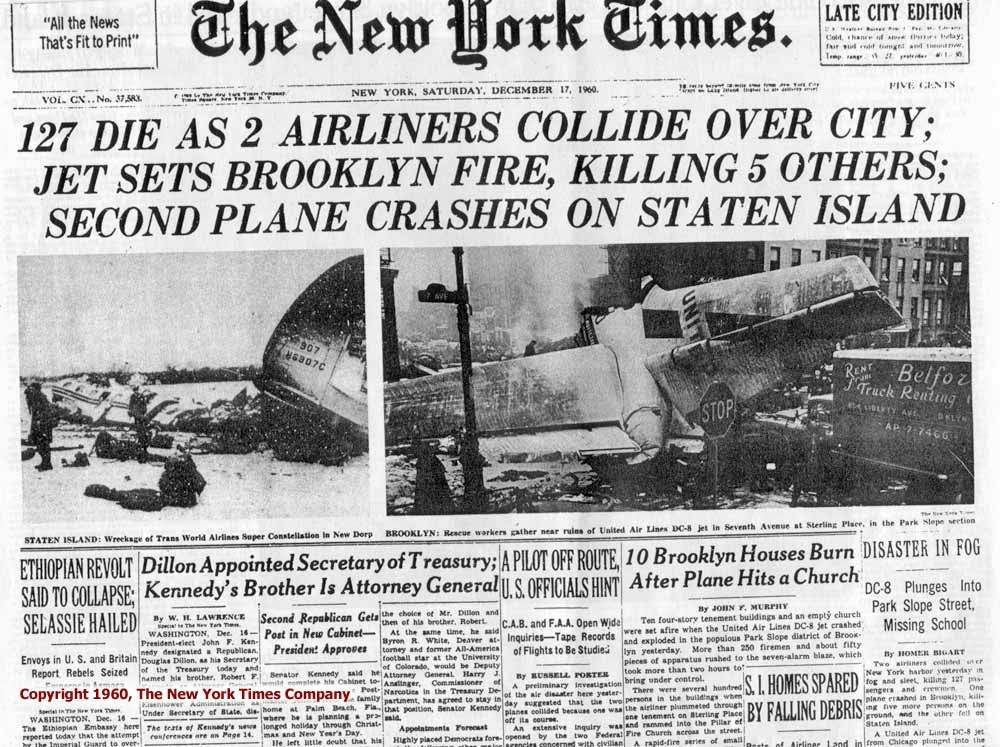
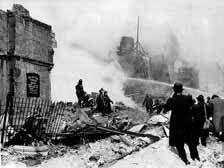 Imagine this scene. It’s an early morning, 9 days before Christmas. The snow that had fallen a day or so ago was now turning into slush under the constant footfalls of people taking care of the daily business. The sky above was grey with dark clouds, which were letting down a wet snow on the streets. Suddenly, falling from the sky, a commercial aircraft is descending upon the city streets and crashes down, engulfing the area with flames. Sounds like something out of a disaster movie doesn’t it? Well, it really happened, and it happened in the Park Slope section of Brooklyn on December 16, 1960.
Imagine this scene. It’s an early morning, 9 days before Christmas. The snow that had fallen a day or so ago was now turning into slush under the constant footfalls of people taking care of the daily business. The sky above was grey with dark clouds, which were letting down a wet snow on the streets. Suddenly, falling from the sky, a commercial aircraft is descending upon the city streets and crashes down, engulfing the area with flames. Sounds like something out of a disaster movie doesn’t it? Well, it really happened, and it happened in the Park Slope section of Brooklyn on December 16, 1960. The sound of the was described by a witness to have sounded like ‘a thousand dishes crashing from the sky’ was in actuality a United Airlines DC-8 carrying 84 passengers. The plane was a victim of a mid air collision due to lack of visibility due to inclement weather with a smaller TWA Connie aircraft. The TWA Connie (aka the Lockheed Super Constellation) was a small plane that was powered by four propeller engines and had a cruising speed of 325 mph and could carry up to 64 passengers. The DC-8 (aka the Douglas DC-8 Jet) was the largest commercial plane at the time and was powered by four turbojet engines and had a cruising speed of 579 mph and could carry up to 189 passengers.
The sound of the was described by a witness to have sounded like ‘a thousand dishes crashing from the sky’ was in actuality a United Airlines DC-8 carrying 84 passengers. The plane was a victim of a mid air collision due to lack of visibility due to inclement weather with a smaller TWA Connie aircraft. The TWA Connie (aka the Lockheed Super Constellation) was a small plane that was powered by four propeller engines and had a cruising speed of 325 mph and could carry up to 64 passengers. The DC-8 (aka the Douglas DC-8 Jet) was the largest commercial plane at the time and was powered by four turbojet engines and had a cruising speed of 579 mph and could carry up to 189 passengers. The smaller plane crash-landed on Staten Island’s Miller Field killing all 44 passengers/crew members. Amazingly, the larger plane was able to stay airborne for another 8 and a half miles before finally succumbing to the damage that was inflicted to it and crash-landed on the streets of residential Park Slope Brooklyn, near the intersection of 7th Avenue and Sterling Street. The crushed body of the plane left a trail of burning cars, bodies and buildings, including the ironically named Pillar of Fire Evangelical church.
The smaller plane crash-landed on Staten Island’s Miller Field killing all 44 passengers/crew members. Amazingly, the larger plane was able to stay airborne for another 8 and a half miles before finally succumbing to the damage that was inflicted to it and crash-landed on the streets of residential Park Slope Brooklyn, near the intersection of 7th Avenue and Sterling Street. The crushed body of the plane left a trail of burning cars, bodies and buildings, including the ironically named Pillar of Fire Evangelical church. Miraculously, one young man of 11 years of age, Stephen Baltz of Wilmette, Illinois was tossed from the plane and landed in a small snow bank. Though he was rescued by police and taken to Methodist hospital, he did not survive his injuries. In addition to all of the passengers of the plane, a number of civilians also perished. In total, 135 people were killed.
Miraculously, one young man of 11 years of age, Stephen Baltz of Wilmette, Illinois was tossed from the plane and landed in a small snow bank. Though he was rescued by police and taken to Methodist hospital, he did not survive his injuries. In addition to all of the passengers of the plane, a number of civilians also perished. In total, 135 people were killed.Here are some links for more information on this plane crash:
The actual article from Time Magazine December 26, 1960
The Report Issued by the DOT in PDF format
An informative article from The Park Slope Reader
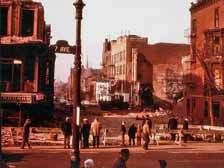
Sunday, February 18, 2007
George Washington and NYC Part I
George Washington: The Revolutionary War Years
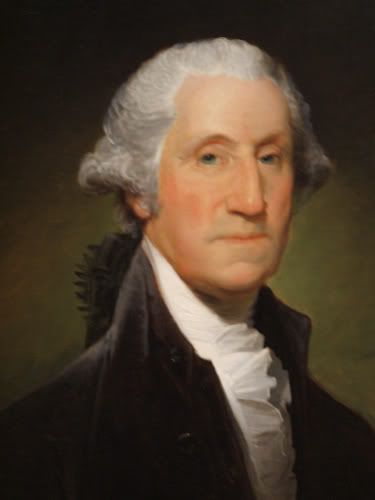 George Washington and the City of New York will forever be historically linked. From the Revolutionary War to Washington’s Presidency, the evolution of George Washington and NYC went hand in hand. Dating as early as March of 1776, George Washington led his army towards New York City. Setting up fortifications on Long Island (Within the borough of Brooklyn) and New York City, Washington awaited the expected British attack. By the time of July 1776, The British had set up their camp on Staten Island and by late August commenced their attack led by overall commander Lieutenant General Sir William Howe.
George Washington and the City of New York will forever be historically linked. From the Revolutionary War to Washington’s Presidency, the evolution of George Washington and NYC went hand in hand. Dating as early as March of 1776, George Washington led his army towards New York City. Setting up fortifications on Long Island (Within the borough of Brooklyn) and New York City, Washington awaited the expected British attack. By the time of July 1776, The British had set up their camp on Staten Island and by late August commenced their attack led by overall commander Lieutenant General Sir William Howe.
With half of his army (at the current location of Flatbush) led by Major General Israel Putnam on Long Island, they locked in battle with the British troops. Led by both Admiral Richard Howe and Major General Sir Henry Clinton, the British troops were able to cause the American troops to withdrawal and retreat to Brooklyn Heights. It was at this location that the American troops were able to retreat on barges over the East River. Due to a lucky stroke of nature, a thick fog bank rolled in and aided to conceal the escape of the American troops from the British. By mid September 1776, New York City was in the hands of the British and the American troops were still in retreat up the island.
 It was during what was known as The Battle of Harlem Heights (Current neighborhoods of Morningside Heights and West Harlem) that the American troops scored some minor victories against the advancing British troops. Though the British troops were slowed, their advance was not halted and the American troops continued their northern retreat. There were continual skirmishes between the troops at Pell’s Point (Pelham Bay Park, Bronx) and White Plains. The ultimate showdown on New York City soil took place at Fort Washington.
It was during what was known as The Battle of Harlem Heights (Current neighborhoods of Morningside Heights and West Harlem) that the American troops scored some minor victories against the advancing British troops. Though the British troops were slowed, their advance was not halted and the American troops continued their northern retreat. There were continual skirmishes between the troops at Pell’s Point (Pelham Bay Park, Bronx) and White Plains. The ultimate showdown on New York City soil took place at Fort Washington.
Located on the highest natural point of Manhattan, Fort Washington was built to provide defense of the Manhattan Island side of the Hudson River in conjunction with Fort Lee on the opposite side of the Hudson (New Jersey side). Under heavy bombardment by both British and Hessian cannons, Fort Washington fell leaving Fort Lee defenseless. Grudgingly, George Washington and his troops retreated from Fort Lee leaving the British to hold New York City for a period of 8 years. With the fall of the British and their eventual evacuation from New York City on November 25, 1783, General Washington led his troops from the North retaking his namesake fort.
 George Washington and the City of New York will forever be historically linked. From the Revolutionary War to Washington’s Presidency, the evolution of George Washington and NYC went hand in hand. Dating as early as March of 1776, George Washington led his army towards New York City. Setting up fortifications on Long Island (Within the borough of Brooklyn) and New York City, Washington awaited the expected British attack. By the time of July 1776, The British had set up their camp on Staten Island and by late August commenced their attack led by overall commander Lieutenant General Sir William Howe.
George Washington and the City of New York will forever be historically linked. From the Revolutionary War to Washington’s Presidency, the evolution of George Washington and NYC went hand in hand. Dating as early as March of 1776, George Washington led his army towards New York City. Setting up fortifications on Long Island (Within the borough of Brooklyn) and New York City, Washington awaited the expected British attack. By the time of July 1776, The British had set up their camp on Staten Island and by late August commenced their attack led by overall commander Lieutenant General Sir William Howe.With half of his army (at the current location of Flatbush) led by Major General Israel Putnam on Long Island, they locked in battle with the British troops. Led by both Admiral Richard Howe and Major General Sir Henry Clinton, the British troops were able to cause the American troops to withdrawal and retreat to Brooklyn Heights. It was at this location that the American troops were able to retreat on barges over the East River. Due to a lucky stroke of nature, a thick fog bank rolled in and aided to conceal the escape of the American troops from the British. By mid September 1776, New York City was in the hands of the British and the American troops were still in retreat up the island.
 It was during what was known as The Battle of Harlem Heights (Current neighborhoods of Morningside Heights and West Harlem) that the American troops scored some minor victories against the advancing British troops. Though the British troops were slowed, their advance was not halted and the American troops continued their northern retreat. There were continual skirmishes between the troops at Pell’s Point (Pelham Bay Park, Bronx) and White Plains. The ultimate showdown on New York City soil took place at Fort Washington.
It was during what was known as The Battle of Harlem Heights (Current neighborhoods of Morningside Heights and West Harlem) that the American troops scored some minor victories against the advancing British troops. Though the British troops were slowed, their advance was not halted and the American troops continued their northern retreat. There were continual skirmishes between the troops at Pell’s Point (Pelham Bay Park, Bronx) and White Plains. The ultimate showdown on New York City soil took place at Fort Washington. Located on the highest natural point of Manhattan, Fort Washington was built to provide defense of the Manhattan Island side of the Hudson River in conjunction with Fort Lee on the opposite side of the Hudson (New Jersey side). Under heavy bombardment by both British and Hessian cannons, Fort Washington fell leaving Fort Lee defenseless. Grudgingly, George Washington and his troops retreated from Fort Lee leaving the British to hold New York City for a period of 8 years. With the fall of the British and their eventual evacuation from New York City on November 25, 1783, General Washington led his troops from the North retaking his namesake fort.
George Washington and NYC Part II
George Washington: Fraunces Tavern, St Paul’s Chapel and Federal Hall
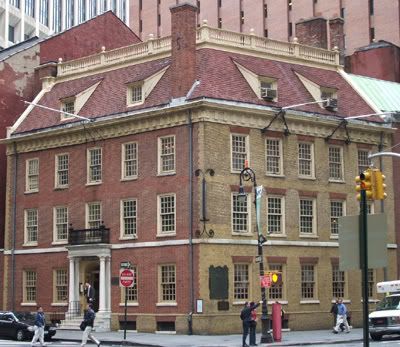 Though General Washington spent many a night at Samuel Fraunces’ Tavern, the night that is most widely known is December 4, 1783. It was within the “Long Room” of Fraunces Tavern that General Washington gave notice of his retirement to his closest Generals. With a fond and emotional farewell, General Washington commenced his journey to his plantation at Mount Vernon.
Though General Washington spent many a night at Samuel Fraunces’ Tavern, the night that is most widely known is December 4, 1783. It was within the “Long Room” of Fraunces Tavern that General Washington gave notice of his retirement to his closest Generals. With a fond and emotional farewell, General Washington commenced his journey to his plantation at Mount Vernon. With General Washington’s election to the Presidency of the Newly Formed United States in 1789, his inauguration would be held at Federal Hall (located at the intersection of Wall and Broad Streets).
With General Washington’s election to the Presidency of the Newly Formed United States in 1789, his inauguration would be held at Federal Hall (located at the intersection of Wall and Broad Streets). 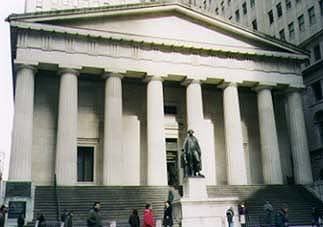 It was at St. Paul’s Chapel (located at Church Street between Fulton and Vesey Streets) that the inauguration mass was held on August 30, 1789 and the eventual inauguration ceremony was held on the balcony of Federal Hall. New York City remained the interim capital until 1790.
It was at St. Paul’s Chapel (located at Church Street between Fulton and Vesey Streets) that the inauguration mass was held on August 30, 1789 and the eventual inauguration ceremony was held on the balcony of Federal Hall. New York City remained the interim capital until 1790.Theodore Roosevelt and NYC
In Honor of Presidents Day, I'm going to be covering two Presidents who have been influential in NYC History. I'm going to be covering it in a three part post. Please feel free to add to the discussion.
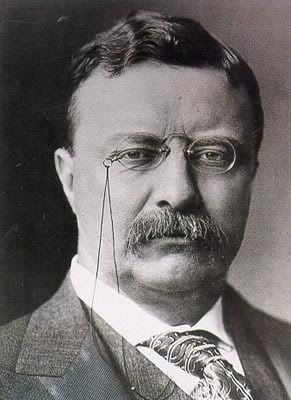 Though there have been a number Presidents born in New York State (Van Buren, Fillmore, Franklin D. Roosevelt) only one President has the distinction of being born in New York City. Theodore Roosevelt was born in New York City on October 27, 1858 and lived at The Roosevelt House located at 28 East 20th Street for a period of 13 years. With his graduation from Harvard University in 1880 Teddy Roosevelt decided to enter the realm of politics. As a member of the Republican Party, he was elected to The New York State Assembly serving three consecutive one-year terms (One of them as Minority Leader).
Though there have been a number Presidents born in New York State (Van Buren, Fillmore, Franklin D. Roosevelt) only one President has the distinction of being born in New York City. Theodore Roosevelt was born in New York City on October 27, 1858 and lived at The Roosevelt House located at 28 East 20th Street for a period of 13 years. With his graduation from Harvard University in 1880 Teddy Roosevelt decided to enter the realm of politics. As a member of the Republican Party, he was elected to The New York State Assembly serving three consecutive one-year terms (One of them as Minority Leader).
Though he lost the New York City mayoral election of 1886 (At the tender age of 28) he gradually became involved in national politics. Having served as The Commissioner of the U.S. Civil Service, Teddy returned to the City of his birth. On May 6, 1895, New York City Mayor William Strong appointed Teddy Roosevelt as the President of New York City’s 4 man Board of Police Commissioners.
Many of his goals as the President of the Board included:
- The Elimination of Bribery for Promotion
- The Enforcement of all laws by Policemen
- The Enforcement of the “Blue Laws” Prohibiting Sunday Drinking
Through his policies (Especially the Blue Laws) turned the once popular Teddy Roosevelt into a reviled figure almost overnight. Through the scheming of the power holding Tammany Hall and other political figures, Teddy Roosevelt looked for an escape. He would eventually find his escape in the form of an appointment to the position of Assistant Secretary of the Navy by President William McKinley in 1897.
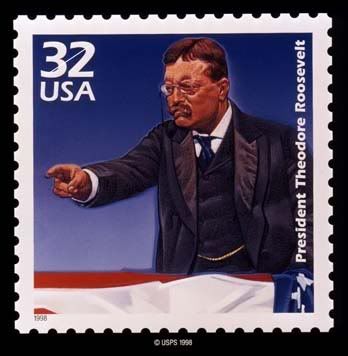 Though he never succeeded in completing all of his goals, he was able to introduce to the police force the bicycle force and mandatory pistol shooting practice. Though he lost his fight against the vices of New York City, his greatest success may have been his introduction to the plight of the poor segments of society that helped to shape many of his Progressive views and later policies.
Though he never succeeded in completing all of his goals, he was able to introduce to the police force the bicycle force and mandatory pistol shooting practice. Though he lost his fight against the vices of New York City, his greatest success may have been his introduction to the plight of the poor segments of society that helped to shape many of his Progressive views and later policies.
Teddy Roosevelt would eventually resign his post as The Assistant Secretary of the Navy to lead the Rough-Riders in the newly declared war on Spain. Upon his return to New York City after the war, he was asked to run for Governor of New York, which he narrowly won. Though his time in office was brief, he alienated most of his party mate within the Republican Party. With his nomination to the ticket of the Vice Presidency with William McKinley, it was deemed by his state’s party machine that he would no longer be a problem of theirs. Though it seemed like the best thing at the time, Teddy Roosevelt would eventually ascend to the highest political office of all with the assassination of President William McKinley in 1901.
 Though there have been a number Presidents born in New York State (Van Buren, Fillmore, Franklin D. Roosevelt) only one President has the distinction of being born in New York City. Theodore Roosevelt was born in New York City on October 27, 1858 and lived at The Roosevelt House located at 28 East 20th Street for a period of 13 years. With his graduation from Harvard University in 1880 Teddy Roosevelt decided to enter the realm of politics. As a member of the Republican Party, he was elected to The New York State Assembly serving three consecutive one-year terms (One of them as Minority Leader).
Though there have been a number Presidents born in New York State (Van Buren, Fillmore, Franklin D. Roosevelt) only one President has the distinction of being born in New York City. Theodore Roosevelt was born in New York City on October 27, 1858 and lived at The Roosevelt House located at 28 East 20th Street for a period of 13 years. With his graduation from Harvard University in 1880 Teddy Roosevelt decided to enter the realm of politics. As a member of the Republican Party, he was elected to The New York State Assembly serving three consecutive one-year terms (One of them as Minority Leader).Though he lost the New York City mayoral election of 1886 (At the tender age of 28) he gradually became involved in national politics. Having served as The Commissioner of the U.S. Civil Service, Teddy returned to the City of his birth. On May 6, 1895, New York City Mayor William Strong appointed Teddy Roosevelt as the President of New York City’s 4 man Board of Police Commissioners.
Many of his goals as the President of the Board included:
- The Elimination of Bribery for Promotion
- The Enforcement of all laws by Policemen
- The Enforcement of the “Blue Laws” Prohibiting Sunday Drinking
Through his policies (Especially the Blue Laws) turned the once popular Teddy Roosevelt into a reviled figure almost overnight. Through the scheming of the power holding Tammany Hall and other political figures, Teddy Roosevelt looked for an escape. He would eventually find his escape in the form of an appointment to the position of Assistant Secretary of the Navy by President William McKinley in 1897.
 Though he never succeeded in completing all of his goals, he was able to introduce to the police force the bicycle force and mandatory pistol shooting practice. Though he lost his fight against the vices of New York City, his greatest success may have been his introduction to the plight of the poor segments of society that helped to shape many of his Progressive views and later policies.
Though he never succeeded in completing all of his goals, he was able to introduce to the police force the bicycle force and mandatory pistol shooting practice. Though he lost his fight against the vices of New York City, his greatest success may have been his introduction to the plight of the poor segments of society that helped to shape many of his Progressive views and later policies.Teddy Roosevelt would eventually resign his post as The Assistant Secretary of the Navy to lead the Rough-Riders in the newly declared war on Spain. Upon his return to New York City after the war, he was asked to run for Governor of New York, which he narrowly won. Though his time in office was brief, he alienated most of his party mate within the Republican Party. With his nomination to the ticket of the Vice Presidency with William McKinley, it was deemed by his state’s party machine that he would no longer be a problem of theirs. Though it seemed like the best thing at the time, Teddy Roosevelt would eventually ascend to the highest political office of all with the assassination of President William McKinley in 1901.